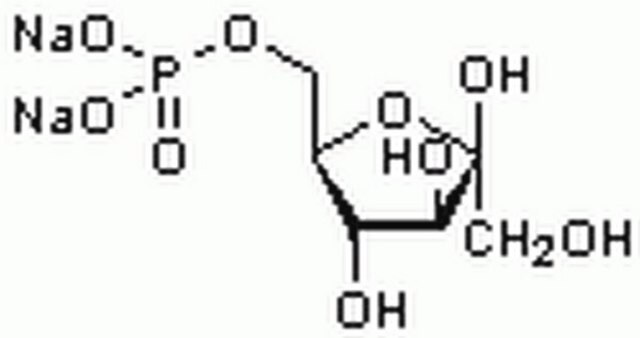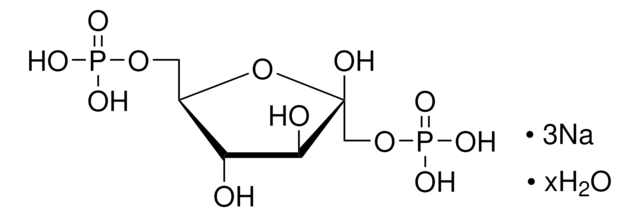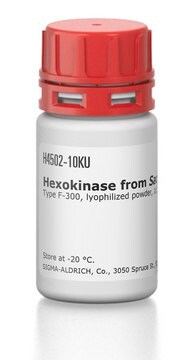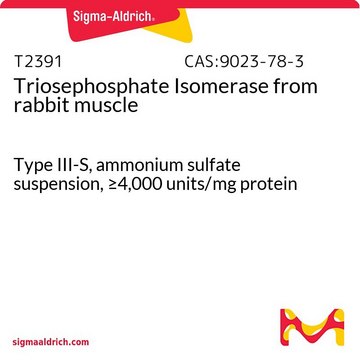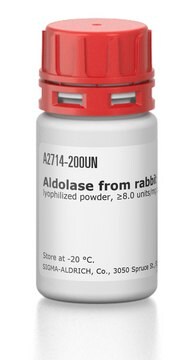F0137
Fructose-6-phosphate Kinase from Bacillus stearothermophilus
Type VII, lyophilized powder, ≥50 units/mg protein
Synonyme(s) :
6-Phosphofructokinase, ATP:D-fructose 6-phosphate 1-phosphotransferase
Se connecterpour consulter vos tarifs contractuels et ceux de votre entreprise/organisme
About This Item
Produits recommandés
Type
Type VII
Forme
lyophilized powder
Activité spécifique
≥50 units/mg protein
Poids mol.
34 kDa
Conditions d'expédition
wet ice
Température de stockage
−20°C
Description générale
Fructose-6-phosphate kinase from Bacillus stearothermophilus, a 34 kDa enzyme, belongs to phosphofructokinase (PFK) - like superfamily. The glutamate 161 and arginine 162 residues at the active site are crucial for substrate binding.
Research Area: Cell Signaling
Bacillus stearothermophilus phosphofructokinase (BsPFK) is a homotetramer that is allosterically inhibited by phosphoenolpyruvate (PEP), which binds along one dimer-dimer interface.
Bacillus stearothermophilus phosphofructokinase (BsPFK) is a homotetramer that is allosterically inhibited by phosphoenolpyruvate (PEP), which binds along one dimer-dimer interface.
Application
Fructose-6-phosphate Kinase from Bacillus stearothermophilus was shown to interact with neuronal nitric oxide synthase (nNOS) causing a defect in glycolytic metabolism and increased fatigability in dystrophic muscle.
Fructose-6-phosphate Kinase from Bacillus stearothermophilus has been used in the assay mixture for mass spectrometry assay for phosphoglucoisomerase (PGI) (G6P to F6P reaction).
Fructose-6-phosphate kinase from Bacillus stearothermophilus has been used:
- in steady state analysis of phosphofructokinase activity in the presence of ATP deuterated at the C8 position(C8-D ATP)
- for standard curve generation for quantifying muscle phosphofructokinase (PFK) activity
Actions biochimiques/physiologiques
Fructose-1,6-bisphosphatase (FBP) is an important enzyme in glucose metabolism. It catalyzes the hydrolysis of fructose-1,6-bisphosphate to fructose-6-phosphate and inorganic phosphate. Fructose-6-phosphate kinase converts fructose-6-phosphate into fructose 1,6-bisphophate in the rate limiting step of the glycolysis cycle.
Phosphofructokinase (PFK) is an essential bifunctional enzyme that serves as a critical regulator in the intermediate stages of glycolysis. PFK is strongly linked to caveolae and is brought to caveolae by caveolin-1 in vascular smooth muscle cells (VSMCs).
Définition de l'unité
One unit will convert 1.0 μmole of fructose 6-phosphate and ATP to fructose 1,6-diphosphate and ADP per minute at pH 9.0 at 30 °C.
Forme physique
Lyophilized powder containing buffer salt (e.g. phosphate buffer, or Tris buffer with NaCl)
Code de la classe de stockage
11 - Combustible Solids
Classe de danger pour l'eau (WGK)
WGK 3
Point d'éclair (°F)
Not applicable
Point d'éclair (°C)
Not applicable
Équipement de protection individuelle
Eyeshields, Gloves, type N95 (US)
Faites votre choix parmi les versions les plus récentes :
Déjà en possession de ce produit ?
Retrouvez la documentation relative aux produits que vous avez récemment achetés dans la Bibliothèque de documents.
Les clients ont également consulté
Loss of positive allosteric interactions between neuronal nitric oxide synthase and phosphofructokinase contributes to defects in glycolysis and increased fatigability in muscular dystrophy
Wehling-Henricks M, et al.
Human Molecular Genetics, 18(18), 3439-3451 (2009)
Rockann Mosser et al.
Biochemistry, 52(32), 5421-5429 (2013-07-19)
Bacillus stearothermophilus phosphofructokinase (BsPFK) is a homotetramer that is allosterically inhibited by phosphoenolpyruvate (PEP), which binds along one dimer-dimer interface. The substrate, fructose 6-phosphate (Fru-6-P), binds along the other dimer-dimer interface. Evans et al. observed that the structure with inhibitor
Analysis of the phosphofructokinase subunits and isoenzymes in human tissues
G.A. Dunaway et al.
The Biochemical Journal, 251, 755-757 (1988)
Chunsheng Liu et al.
American journal of physiology. Gastrointestinal and liver physiology, 307(7), G749-G759 (2014-08-30)
Platelet-derived growth factor (PDGF) and transforming growth factor-β (TGF-β) signaling are required for hepatic stellate cell (HSC) activation under pathological conditions such as liver metastatic tumor growth. These two signaling pathways are functionally divergent; PDGF signaling promotes proliferation and migration
M Hattori et al.
Nature, 405(6784), 311-319 (2000-06-01)
Chromosome 21 is the smallest human autosome. An extra copy of chromosome 21 causes Down syndrome, the most frequent genetic cause of significant mental retardation, which affects up to 1 in 700 live births. Several anonymous loci for monogenic disorders
Notre équipe de scientifiques dispose d'une expérience dans tous les secteurs de la recherche, notamment en sciences de la vie, science des matériaux, synthèse chimique, chromatographie, analyse et dans de nombreux autres domaines..
Contacter notre Service technique
